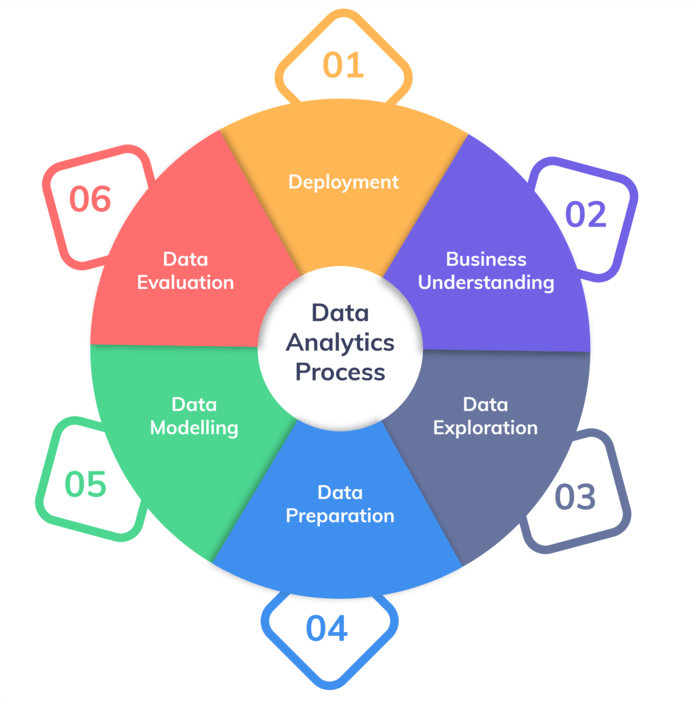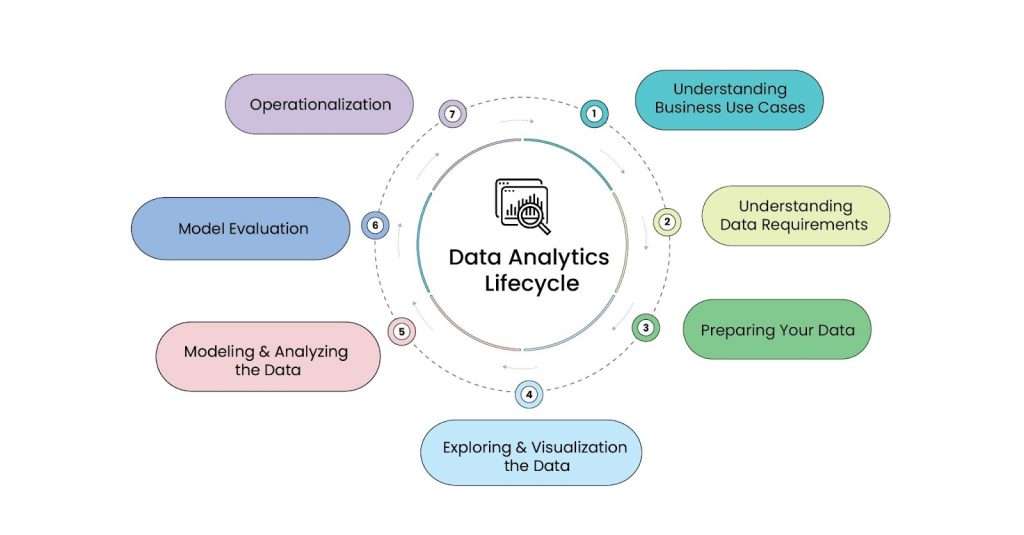
- Data analytics: What is it?
- The Value of Big Data
- Tools for Data Analytics
- Importance of Data Analytics
- The distinction between data analytics and data science
- Data Analytics Types
- Data Analytics Lifecycle
- How to Become a Data Analyst?
- Challenges in Data Analytics
- Future Trends in Data Analytics
- Conclusion
Data analytics: What is it?
Data analytics is the science of analyzing unprocessed data to derive conclusions about it. With the help of data analytics, a firm may maximize profit, operate more efficiently, optimize performance, and make more strategic decisions. Data analytics uses a variety of software tools, such as spreadsheets, data visualization and reporting tools, data mining software, or open-source languages, to manipulate data extensively.

Organizations can use data analytics to uncover patterns and trends that might not be immediately obvious. By employing statistical approaches and machine learning algorithms, such as Machine Learning k Means clustering, organizations can forecast future outcomes, understand client behavior, and adjust their strategies accordingly.
Want to Earn Your Data Analytics Professional Certification? Check Out the Data Analytics Certification Course Available at ACTE Now!
The Value of Big Data
Data analytics makes prediction and knowledge discovery possible. It helps understand the current state of the business or process and provides a solid basis for forecasting future outcomes. Companies can use data analytics to make process adjustments, better understand the market, or decide whether to create to meet consumer demand. Marketing initiatives are more individualized based on sophisticated insights into client preferences. It enables companies to focus their marketing efforts on specific segments of their clientele. Data analytics can help organizations identify additional opportunities to enhance productivity or boost profits. By anticipating potential issues and taking action before they arise, a corporation can feel more at ease. Utilizing tools like Julia for data analysis can further streamline these processes and improve decision-making. Companies can also evaluate which procedures yielded the best outcomes, which ones might have errors, and which ones need to be improved.
Tools for Data Analytics
- Python: Python is a computer language with numerous features that is very adaptable and is often used to simplify large and complicated data collections. It provides a range of unique features that make it a great option for analysis.
- Hadoop: Hadoop revolutionizes the fields of analytics and big data. Information gathered about people, things, technology, procedures, and other topics is only useful when it starts to show patterns that lead to wiser choices.
- SQL: Structured Query Language is used to carry out operations such as adding, removing, updating, and changing records in a database. Nowadays, the most widely used use of SQL (in all its incarnations) is as a building block for basic reporting and dashboard applications, frequently referred to as SQL for data analytics.
- Tableau: With Tableau, you can prepare, analyze, collaborate, and share big data insights. Tableau is a comprehensive Data analytics platform. Tableau is a master at self-service visual analysis, enabling users to share their findings throughout the enterprise instantly and pose new queries of large, controlled data sets.
- Splunk: Splunk helps companies make the most of their server data. This provides efficient security monitoring, compliance, application administration, and IT operations management.
- R programming: R analytics is data analytics using the R programming language, an open-source language typically used for graphics and statistical computing. This programming language is widely utilized for data mining and statistical utilized.
Importance of Data Analytics
- Informed Decision-Making:Data analytics makes sense in the present age of voluminous data; this means that organizations that use data analytics can be better decision-makers. It lets businesses make more strategic decisions and operate more efficiently because companies rely more on data-driven insights than intuition.
- Better Customer Experience:Analytics helps an organization understand its customers’ needs and preferences. Based on inferences drawn from customer data, the organization is in a position to offer customized products and services. Analytics also enhances customer support services so that more can be done to increase overall satisfaction, which helps build better loyalty and retention.
- Operational Efficiency:Data analytics helps identify inefficient processes. It can streamline operations, improve efficiency by reducing costs and productivity, and help in effective resource allocation to achieve performance maximization through workflow data analytics.
- Competitive advantage:Competitive advantage refers to the benefit an organization achieves in utilizing data analytics. Business firms can adapt to market trends, customer preferences, and competitive dynamics to stay abreast of their competitors and innovate.
- Risk Management: Data analytics is an important risk identification and management form. It analyzes data on market conditions, financial performance, and processes to prevent issues in advance with proper risk management decisions.
To Obtain Your Data Analytics Certification, Learn from Leading Data Analytics Experts and Advance Your Career with ACTE’s Data Analytics Certification Course.
The distinction between data analytics and data science
Despite the fact that the phrases are commonly used interchangeably, the main distinction between Data Science and data analytics lies in their respective scopes. The term “data science” encompasses a broad range of disciplines that mine vast amounts of data. In contrast, data analytics provides a more specialized approach, often seen as a part of a larger process. Analytics focuses on generating actionable insights based on pre-existing queries that can be applied immediately.
Another significant distinction between the two is exploration. Data science aims to find information by searching massive databases, sometimes in an unstructured way. It is not interested in giving answers to particular queries. It performs best when data analysis is directed towards specific issues that require existing data to be answered. While data science produces more comprehensive insights that centre on questions that need to be answered, data analytics prioritizes answering questions that have already been asked.
Data Analytics Types
- Predictive analytics: Predictive analytics is a core business advanced analytics technology relying on various techniques, including statistical modelling, data mining, and even machine learning, to understand past information about events that will happen. The strength of using this analytical tool makes any organization realize trends, patterns, and relationships within their data to make decisions based on expected outputs.
- Descriptive analytics: Descriptive analytics forms the core work of the data analysis process, which includes summarizing and interpreting current and historical data to find trends, patterns, and relationships. As such, this analytics plays a crucial role in the sense that it can help organizations have an exact idea regarding their past and present performance and assist in making appropriate decisions with concrete evidence.
- Prescriptive analytics: Prescriptive analytics is a sophisticated analytical technology that goes beyond mere forecasting and descriptive insight through actionable recommendations on optimizing business operations and producing a desired outcome. Based on data analysis, machine learning, and algorithmic modelling, it informs an organization of what is likely to happen and when and provides underlying reasons for the predictions.
- Diagnostic Analytics: It is an important part of advanced analytics. Through the analysis of data and information, it discovers the underlying why behind what has happened in the past. It answers the most pressing question around “why it happened,” and the insights gained go beyond mere observation. An important area of analytics for businesses, it’s applied to determine the root causes of the problem, analyze performance metrics, and understand the forces driving a business’s operations.
How to Become a Data Analyst?
The most crucial first step towards becoming a data analyst is acquiring the right degree in statistics, mathematics, computer science, or even data science. If properly taught, programming languages like R Programming, Python, SQL, and various data analysis tools should be well understood. Practical experience can be gained through projects, internships, or by applying to real-world data sets. Additionally, proficiency in data visualization tools like Tableau and Power BI is essential. Developing critical thinking and problem-solving skills is also important. Networking and taking online classes can enhance your knowledge. Make sure to have a strong portfolio when approaching future employers.
Ready to Master Data Science? Explore the Data Science Master Program Available at ACTE Today!
Data Analytics Lifecycle
- Discovery: In the initial stage of data analytics, stakeholders typically evaluate business trends, study case studies of related data analytics, and investigate the company industry.
- Data preparation: Following the data discovery stage, the data is transformed from current systems into a data analytics format using the sandbox platform in the second step of data preparation.
- Model planning: In the third stage of the life cycle, they carefully prepare the multiple workflows to be followed during the following stage of model construction and the methodologies to be modified.
- Operationalization: During phase six, the team compiles a final report with briefings, source codes, and pertinent papers. The final phase also includes implementing the pilot project and evaluating the model in a real-time setting.

- Model construction: The next stage of the cycle is model development, in which the team builds datasets for training, testing, and production. Furthermore, the model is implemented based on the planning completed in the previous stage.
- Communicate results: In phase five of the life cycle, the project’s outcomes are examined to ascertain its success or failure. The team and all involved parties thoroughly review the results to draw conclusions about the significant findings and gather all completed work.
Challenges in Data Analytics
- Data Quality Issues can lead to Inaccurate Insights: Organizations should improve data quality by ensuring accuracy, consistency, and relevance.
- Increasing concerns over data privacy and regulations, such as GDPR, are demanding organizations that organizations handle the complexities relating to their data responsibly.
- There will typically be a surplus demand for data analytics skills. Organizations, therefore, find it challenging to obtain the qualified personnel they require to interpret analysis results effectively and correctly.
- Many organizations have spread data across different systems. This makes integration cumbersome and time-consuming.
Geared Up for an Data Analytics Job Interview? Browse Our Comprehensive Set of Data Analytics Interview Questions to Help You Prepare!
Future Trends in Data Analytics
- Artificial Intelligence and Machine Learning:This integration will enhance maturity in predictive and prescriptive analytics, allowing organizations to derive deeper insights from data processing through Artificial Intelligence.
- Real-time Analytics: The demand for in-depth analysis of real-time data is increasing. Businesses are now investing in technologies that enable them to make on-the-spot decisions based on live data.
- Augmented Analytics:This is the new trend, leveraging AI to automate data preparation and insight generation so that less technical users can use analytics.
- Data democratization: Organizations now make sure that data is accessible at all levels so that any employee can make data-based decisions.
- Ethical AI:As data usage becomes the central point, the ethics of data analytics, i.e., fair and transparent algorithms, will boom.
Conclusion
Data analytics is one of the main factors propelling some of the biggest and best companies in the world today. Businesses that can transform data into actionable information will surely prosper in this fiercely competitive climate. Therefore, any company may easily outperform its rivals if it employs data analytics correctly. Moreover, data analytics enables organizations to understand customer behavior and preferences, leading to more personalized products and services.
By leveraging advanced analytical techniques, companies can identify trends, forecast demand, and enhance operational efficiency. This strategic use of data not only boosts profitability but also fosters innovation, allowing businesses to adapt quickly to market changes and stay ahead of the competition. Embracing data analytics is essential for any organization aiming for long-term growth and success in today’s data-driven landscape.






